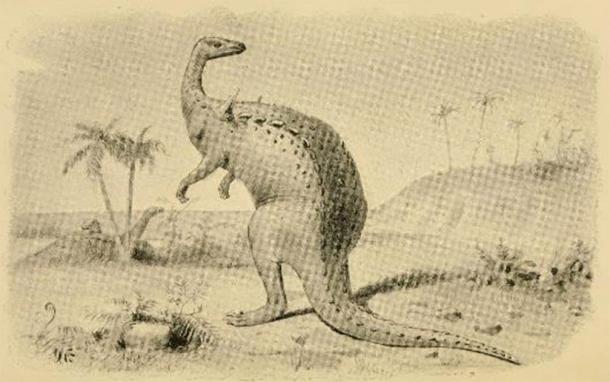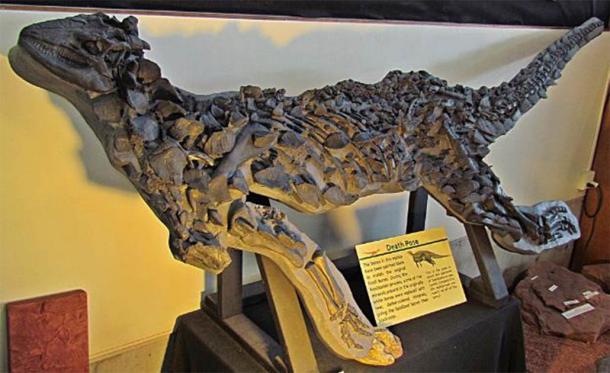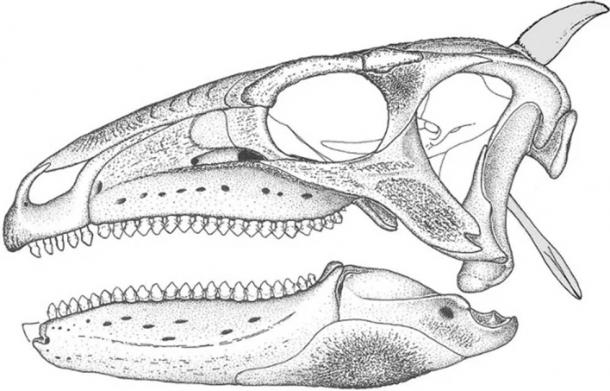Science: World’s First Complete Dinosaur Skeleton Has Been Vividly Brought to Life
(005875.811-:E-000062.43:N-AC:R-SU:C-30:V)
A team of English scientists have unboxed the first complete dinosaur skeleton ever discovered, and after over 150 years the remains have finally been fully studied and recorded. Previously unknown traits have been discovered, as well as giving it a new home on the evolutionary timeline.
Rise of the First Terrible Lizard
Sir Richard Owen (1804 – 1892) was a controversial English biologist, comparative anatomist, and paleontologist who spent a lifetime interpreting fossils. He eventually assisted Benjamin Waterhouse Hawkins (1807 – 1894), the English sculptor and natural historian, in creating the first life-size sculptures depicting dinosaurs. Those sculptures were made for for the Great Exhibition of 1851 in London’s Crystal Palace and were seen by over six million people that year.
Owen’s research identified several anatomical similarities between modern reptiles and the skeletons of giant ancient creatures that were being excavated across Victorian England , and it was he who published the first work on Mesozoic land-reptiles, which he named Dinosauria, from the Greek words “ deinos,” meaning “terrible, powerful or wondrous”, and “ sauros” meaning “lizard”: directly translated to “ Terrible Lizards”.

Bipedal Scelidosaurus illustration from 1896. (FunkMonk/ CC BY 2.0 )
The Story of the Lost Limb Lizard
According to a report on Science Daily , in 1850 James Harrison, a quarry owner in West England, sent a curious boulder he had found imprinted with fossilized leg bones and a skull to Richard Owen at the British Museum . When Owens completed his study he announced to the world that the fossils encased in this stone represented the very first practically-complete dinosaur skeleton ever discovered. And because of its extremely well-developed hind legs in 1859 Owen named this ancient beast “ Scelidosaurus,” the “limb lizard”.

Replica of a Scelidosaurus skeleton. (FunkMonk/ CC BY SA 2.0 ) The first complete dinosaur skeleton was a Scelidosaurus.
And while in 1861 Owen described this creature as a partially sea-dwelling fish-eater, he failed to make a life-size reconstruction of the creature, and he also neglected any attempt to place the dinosaur into historical context in a timeline with other species. And because in the following decades the fossils of much larger and more newsworthy dinosaurs were discovered, Owen’s “limb lizard” faded into relative obscurity and became all but forgotten in the vaults of London’s Natural History Museum . Until now this is…
- Footprints on the Wall: Were Dinosaurs Actually Climbing the Cliffs in Bolivia?
- Is the Creature Carved Into Angkor Temple Wall a ‘Domestic’ Dinosaur?
- Chinese Boy Accidentally Finds 66-Million-Year-Old Dinosaur Eggs
Resurrecting the First Complete Dinosaur Skeleton
Marcel Proust said, “The real voyage of discovery consists, not in seeking new landscapes, but in having new eyes,” and this sentiment applies directly to paleontologist David Norman of Cambridge University’s Department of Earth Sciences . Professor Norman and his team studied Owen’s overlooked dinosaur specimen and a new paper they detail how Scelidosaurus had lived around 194-million-years-ago in forested regions that are now submerged beneath the former British Sea . The results of Norman’s work, published as four separate studies in the Zoological Journal of the Linnean Society of London , not only reconstruct what Scelidosaurus looked like in life, but reveal that it was an early ancestor of ankylosaurs, the armour-plated ‘tanks’ of the Late Cretaceous Period.
The new analysis shows that while Scelidosaurus was a relatively slow-moving creature measuring about 4 meters (13 ft) long, and its entire body was protected inside a thick case of armor, composed of bony spikes, plates and horny scutes. The creature’s teeth and jaw indicated that it was an herbivore that mostly fed on undergrowth. And it was also discovered that the creature probably stood on its hind legs to reach low foliage growing on trees, but its relatively long arms indicated that it had a greatly quadrupedal posture.

Skull of a Scelidosaurus. ( University of Cambridge )
Visualizing a 194-Million-Year-Old Creature
In the most part we humans are a very visually orientated group of creatures who say things like “photographs speak a thousand words,” and the inordinate success of Instagram perhaps speaks loudest about our thirst to be stimulated with graphical representations of reality. It is for this reason perhaps the most fascinating aspect of the new study is the new reconstruction of Scelidosaurus.
Not only does this new study let us see how this lost dinosaur would have looked when it was grazing in the ancient forests of Europe, but the researchers also completed another major task that Owen had failed to do: they inserted the creature into a new found chronological station of the dinosaur evolutionary time line.
It was after establishing the creature’s 194-million-year-old origins that the team of researchers managed to determine that Scelidosaurus was not an ancestor of the Stegosaurian dinosaurs, an idea that has long been suspected in paleontological circles – instead it was an ancestor of the ankylosaurs which emerged around 68–66 million years ago.
Source: https://www.ancient-origins.net/news-science-space/dinosaur-skeleton-0014229
Video: Orania: The Afrikaner city on its way to freedom! (English subtitles)
These are good people. I was there in 2010. They‘re expanding and looking for more people to go there. Jan
Video: Napoleon: Jews are GUILTY until proven Innocent!
This is the story of how Napoleon tried to solve the Jewish problem in Europe nicely. He got all the Jews together. Then the Jews proceeded to lie to him and he realised it!
Video: Short Lesson: Dr William Pierce: How WW2 really started. What you were NOT told
How did WW2 begin? Dr William Pierce, was an aeronautical scientist who became a right winger in the USA.

